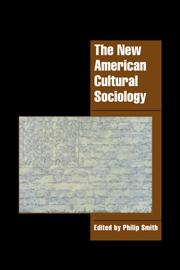Book contents
- Frontmatter
- Contents
- Notes on contributors
- Preface
- The new American cultural sociology: an introduction
- PART I Culture as text and code
- PART II The production and reception of culture
- PART III Culture in action
- 11 Culture and social action
- 12 Culture, structure, agency, and transformation
- 13 Discourse, nuclear power, and collective action
- 14 Moral boundaries, leisure activities, and justifying fun
- 15 Honor and conflict management in corporate life
- 16 The role of cultural capital in school success
- Index
- Title in this Series
14 - Moral boundaries, leisure activities, and justifying fun
Published online by Cambridge University Press: 18 January 2010
- Frontmatter
- Contents
- Notes on contributors
- Preface
- The new American cultural sociology: an introduction
- PART I Culture as text and code
- PART II The production and reception of culture
- PART III Culture in action
- 11 Culture and social action
- 12 Culture, structure, agency, and transformation
- 13 Discourse, nuclear power, and collective action
- 14 Moral boundaries, leisure activities, and justifying fun
- 15 Honor and conflict management in corporate life
- 16 The role of cultural capital in school success
- Index
- Title in this Series
Summary
Some activities receive social approval; others are sneered at or even punished. Within a community, parties may battle over the meaning of an activity, with competing groups having strikingly different definitions and justifications.
This labeling argument is well recognized in sociological studies of deviance, stigma, and criminal behavior. Behaviors such as gambling, prostitution, or smoking are not automatically rejected but can be made so through public debate and legislative action. This labeling approach has been less discussed in examinations of expressive culture.
Olmsted (1988) spoke of a class of voluntary activities he termed “morally controversial leisure.” He recognized that some activities – gun collecting, motorcycling, pool, or pinball – have a moral stigma attached to them. Dungeons and Dragons (Fine 1983; Martin and Fine 1991) is a recent example of a game that has been transformed into a controversial activity: a game that some suggest promotes suicide or Satanism. Moral entrepreneurs attempt to attach a label to a form of play that, for many players, is without a clear moral valuation. The controversy about war toys (Carlsson-Paige and Levin 1990; Sutton-Smith 1988) is another instance in which ideological politics influences the determination of children's play. Play and leisure matter in the organizing of society.
My underlying argument is that play and leisure ultimately are not separate from the values of the society but are a reflection of them and that they are often introjected into the political debate. Olmsted's (1988) emphasis on the class-based dynamics of labeling is compelling.
- Type
- Chapter
- Information
- The New American Cultural Sociology , pp. 217 - 229Publisher: Cambridge University PressPrint publication year: 1998



